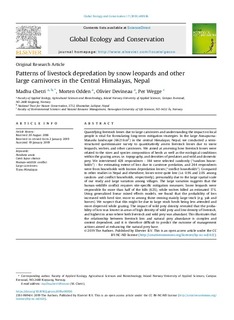| dc.contributor.author | Chetri, Madhu | |
| dc.contributor.author | Odden, Morten | |
| dc.contributor.author | Devineau, Olivier | |
| dc.contributor.author | Wegge, Per | |
| dc.date.accessioned | 2019-09-17T07:24:26Z | |
| dc.date.available | 2019-09-17T07:24:26Z | |
| dc.date.created | 2019-02-02T12:58:03Z | |
| dc.date.issued | 2019 | |
| dc.identifier.citation | Global Ecology and Conservation. 2019, 17 1-11. | nb_NO |
| dc.identifier.issn | 2351-9894 | |
| dc.identifier.uri | http://hdl.handle.net/11250/2617108 | |
| dc.description.abstract | Quantifying livestock losses due to large carnivores and understanding the impact on local people is vital for formulating long-term mitigation strategies. In the large Annapurna-Manaslu landscape (6621 km2) in the central Himalayas, Nepal, we conducted a semi-structured questionnaire survey to quantitatively assess livestock losses due to snow leopards, wolves, and other carnivores. We aimed at assessing how livestock losses were related to the sizes and species composition of herds as well as the ecological conditions within the grazing areas, i.e. topography, and densities of predators and wild and domestic prey. We interviewed 428 respondents - 184 were selected randomly (“random households”) - for estimating extent of loss due to carnivore predation, and 244 respondents were from households with known depredation losses (“conflict households”). Compared to other studies in Nepal and elsewhere, losses were quite low (i.e. 0.9% and 2.0% among random- and conflict households, respectively), presumably due to the large spatial scale of our study and large variation among villages. The large variation suggests that the human-wildlife conflict requires site-specific mitigation measures. Snow leopards were responsible for more than half of the kills (62%), while wolves killed an estimated 17%. Using generalized linear mixed effects models, we found that the probability of loss increased with herd size, more so among those owning mainly large stock (e.g. yak and horses). We suspect that this might be due to large stock herds being less attended and more dispersed while grazing. The impact of wild prey density revealed that the probability of loss was lowest in areas of high density of wild prey and low density of livestock, and highest in areas where both livestock and wild prey was abundant. This illustrates that the relationship between livestock loss and natural prey abundance is complex and context dependent, and it is therefore difficult to predict the outcome of management actions aimed at enhancing the natural prey base. | nb_NO |
| dc.language.iso | eng | nb_NO |
| dc.relation.uri | https://www.sciencedirect.com/science/article/pii/S2351989418303019?via%3Dihub | |
| dc.rights | Attribution-NonCommercial-NoDerivatives 4.0 Internasjonal | * |
| dc.rights.uri | http://creativecommons.org/licenses/by-nc-nd/4.0/deed.no | * |
| dc.title | Patterns of livestock depredation by snow leopards and other large carnivores in the Central Himalayas, Nepal | nb_NO |
| dc.type | Journal article | nb_NO |
| dc.type | Peer reviewed | nb_NO |
| dc.description.version | publishedVersion | nb_NO |
| dc.source.pagenumber | 1-11 | nb_NO |
| dc.source.volume | 17 | nb_NO |
| dc.source.journal | Global Ecology and Conservation | nb_NO |
| dc.identifier.doi | 10.1016/j.gecco.2019.e00536 | |
| dc.identifier.cristin | 1672586 | |
| cristin.unitcode | 192,14,0,0 | |
| cristin.unitname | Miljøvitenskap og naturforvaltning | |
| cristin.ispublished | true | |
| cristin.fulltext | original | |
| cristin.qualitycode | 1 | |

